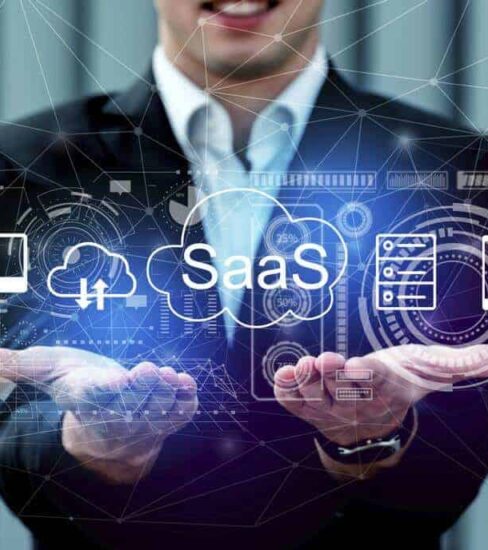Enterprise resource planning (ERP) systems are essential for businesses of all sizes across industry verticals. They protect your sensitive business data and allow you to conduct everyday business operations efficiently and smoothly. However, when choosing an ERP solution, you will need to choose between on-premises, software-as-a-service (SaaS), or cloud ERP deployment methods.
What are the differences between on-premises, cloud, and SaaS ERP?
On the surface, the difference between on-premises ERP and cloud/SaaS ERP is quite clear. On-premise ERP is deployed on your own IT infrastructure, allowing you to supervise and secure data with total control. However, you will also need a dedicated IT team to maintain and operate it and fix bugs as they appear.
On the other hand, cloud and SaaS ERP are delivered over the internet. They are easily customizable, come with support for maintenance and bug fixes, and are updated regularly by the vendor. Consequently, Cloud and SaaS ERP are the preferred deployment methods for both small and large businesses. In fact, many people use the words “Cloud ERP” and “SaaS ERP'' interchangeably.
Although Cloud and SaaS ERP have many things in common, some significant differences exist. In this article, we take a quick look at how Cloud and SaaS ERP compare against each other and which is more suitable for your needs.
|
Cloud ERP |
SaaS ERP |
|
Pay an upfront fee or choose a monthly/annual plan |
Pay a monthly or yearly fee and start using the ERP without installation. |
|
Cloud ERP servers are located in offsite data centers. |
The SaaS ERP provider or another third-party vendor may own servers. |
|
Cloud ERP does not have hidden costs, and your expenses are discussed before deployment. |
If you add more users or modules, your costs can climb up quickly. |
|
A single-tenant cloud ERP offers users more control over data, as you can control your maintenance and upgrades, including any customizations done to the software. |
Multi-tenant SaaS ERP is on the other end of the spectrum. The vendor handles all your patches, upgrades, and maintenance and is responsible for software and hardware. |
|
You may sometimes require an in-house IT team. Vendor-based IT support cost extra. |
You do not have to invest in an in-house IT team. |
|
A Cloud ERP is a better option if your business is unique and has many customizations to make. |
If you run a small business and have just started to explore the world of ERP, you might benefit from a SaaS ERP. |
|
A Cloud ERP gives you more control while giving you access to IT and customer support staff when needed. But this may cost extra. |
Your ERP is always up-to-date, giving you a competitive edge. Your SaaS vendor takes care of customer support, IT support, etc. |
|
Excellent security features, thanks to single tenancy. |
Security-related concerns may appear if your vendor is unreliable. |
|
Can be customized to comply with HIPAA and GDPR |
SaaS ERP solutions often automatically comply with regulatory bodies such as HIPAA and GDPR. As they are always up date, without intervention. |
Cloud ERP is perfect for both nascent and seasoned companies
Cloud ERP has all the benefits of on-premise ERP and is perfect for growing businesses. It is secure, risk-free, and flexible in terms of scaling. Cloud ERP allows you to focus on running your business instead of spending time on IT administration. A good cloud ERP solution will offer you the following features in addition to what you can expect from an on-premise solution:
- Significantly less expensive than on-premise solutions
- Automatic upgrades of your ERP solution
- Fast and seamless data migration process
- Ability to customize, scale, and add third-party integrations
SaaS ERP is perfect for smaller startups
SaaS ERP has the advantage of quicker deployment and reduced upfront costs. However, in comparison to Cloud ERP, it offers fewer opportunities for customization. Multiple tenants use SaaS ERP solutions, making it much cheaper and accessible to smaller and medium-sized businesses. You can easily predict your operating expenses as there are no hidden costs. However, costs can increase when you add modules or scale in terms of users. Here are a few things to bear in mind before choosing SaaS ERP.
- Poses challenges if you move data from on-premises ERP to a cloud ERP.
- It is cheaper and easier to access, and you can also add features and users as your business grows.
- Access to all the primary ERP modules and the freedom to add or remove modules depending on your requirements
Priority’s Cloud ERP hits the sweet spot
Priority’s Cloud ERP product allows you to work anywhere, anytime. You and your staff can work on any device. All your data is synchronized in real-time over cloud servers, eliminating duplicate or redundant entries. You will always have access to an up-to-date database stored on a centralized server accessible online. In fact, it combines the best of both worlds – the customizability of Cloud ERP and the ease-of-use of SaaS ERP. Priority’s Cloud ERP offers the following features:
- Real-time visibility of your business processes.
- Global access to tools you need to manage your business on any device, anywhere
- Your ERP is ready to use in less time than on-premise systems
- Regular software updates and bug fixes
- A flat-rate fee that reduces your ERP implementation costs
- Compliant with SOC1 and ISO 27001, which ensures enhanced security
- Access to top-notch customer support round the clock
In addition to Financials, CRM & Sales, Supply Chain Management, and Human Resource Management, you can also add other modules such as WMS, Project Management, Payments, Business Intelligence, Time & Attendance and Equipment Rental. In short, you get everything you need to run a business smoothly and successfully without ever having to install an ERP on your IT infrastructure.
To find out more about Priority’s Cloud ERP and how it can help you take your business to the next level, contact us today.


